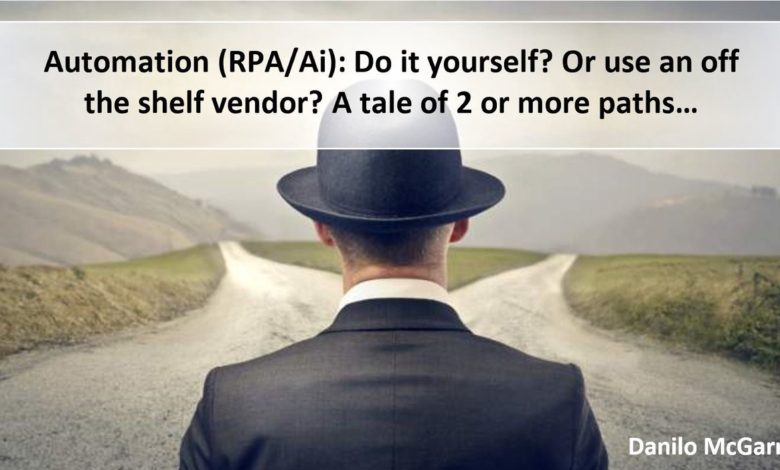
When starting off an automation program (RPA or AI) most are faced with the difficult decision of either using a vendor or doing it yourself.
According to ISG Research, in 2019, 9 out of 10 firms will be faced with this decision.
Equally as important, when you have already embarked on an automation journey, how should your program evolve and go to the next level?
Here is how to make that difficult choice easier.
Times have changed
3 years ago the answer to this question would have been hugely different and completely open to debate (mainly due to the lack of education that causes confusion and misinformation).
The reasons being (to name a few):
1. Vendors were not ready yet with fully tried and tested platforms, despite all the wonderful marketing they did claim otherwise
2. Most people didn’t truly understand what RPA and AI is and would use these terms to generate hype, surprisingly still many don’t understand what each of these technologies is and what they do
3. In the past, there was an increasing conflict of interest between advisory firms and vendors on many dynamics
4. Prices of vendor solutions were exuberant, almost forcing companies to try it out on their own
5. Conflicts of interest between those against automation and those supplying the IP was even worse than it is today again due to lack of education and understanding
6. Budget constraints — years ago many leaders didn’t believe in RPA/AI and thus didn’t release enough funds or make it a central enough recipe to ensure its future success
*still the above exists today but to a lesser extent
The best path to take depends on where you are on your journey today
Companies that chose to adopt the DIY (do it yourself) model years ago are either at a point today where their program got canned because it didn’t live up to the hyper.
If you are in this situation don’t be too harsh on yourself, years ago when you tried to be an innovator many odds were stacked against you, OR, they are at a point where some benefit was provided but they are now looking at integrating their RPA teams under one umbrella or federation.
It’s likely 1–2 vendor platforms will get chosen to provide a unified foundation from which to build upon.
Companies that never initiated the automation journey are probably splurging, or are going to splurge, serious dollars on advisory, which if impartial would most likely suggest they go with a vendor off the shelf solution.
Especially as now most of the larger vendors have tried and tested platforms, which are far more affordable, making the ROI business case a far easier sell.
It is likely that a company looking to embark on an Automation program will also end up choosing to outsource the platform it needs because RPA/AI developers are unlike most other typical developers in the market today so most likely they won’t be able to use their existing technical teams.
Either way, I would say that the best option, for a new Automation initiative, would be to go with a vendor solution for various reasons (to name a few):
1. It provides you with a set of acronyms, code, approach, methodology, which under the ever confusing/evolving world of automation, this can be a great confusion buster, especially for your internal stakeholders
2. Learning from a vendor’s experience from other industries can be a great accelerator for a new automation initiative.

Biggest trends for Automation in 2019/2020
These are based on my own predictions, what I have learned from consultants, tradeshows, and other leaders in the field of Automation. Just the headlines and a brief explanation since this is only a brief article:
1. Merging/Consolidation of technologies will become easier and a general goal. IoT, Blockchain, ERP, and Big Data will start to integrate exponentially harnessing more accurate and reliable usage of technology
2. RPA will finally get fully integrated with AI: where RPA will be utilised for simpler and more appropriate use cases and AI will be utilised for the harder, multi-scenario cognitive related tasks. This will give exponential opportunities and accuracy to NLP and OCR capabilities
3. Senior leadership of most significant corporates will centralise the success of automation as part of their company’s core strategic objectives
4. Consolidation in the vendor/solutions market: as the RPA/AI vendor market saturates and its competitors fight for optimal market positioning there will undoubtedly be direct overlaps. The key here is that most of the larger RPA/AI vendors have managed to raise hundreds of millions of dollars in seed funds, while will allow them to have the choice of creating their own new/improved capabilities (to adjust their market positions) or consolidate with another competitor. 2019/2020/2021 I believe will be years of M&A activity in this space, backed by PE and Funds are given it’s a market that is growing at over 50% CAGR YoY
For the more advanced automation programs, the answer is a bespoke model
First of all, let me explain what I mean by “a more advanced automation program”.
To me at least, an advanced automation program is one that has been in existence for a number of years, who have a real developed roadmap for their existing RPA opportunities and have delved into the world of Artificial Intelligence for a number of business cases.
A more advanced Automation program is one that has also made numerous mistakes, in handling their stakeholders, in not choosing their automation use case carefully…etc., it is also one that realises the fundamental differences between RPA and AI (of which there are many).
Last but not least, a more advanced automation program is one that has started to become integral to their business’s cost-saving initiatives and thus in their company’s competitive advantage agenda. They may or not be the only Automation program but are definitely the CoE within their org.
Now that definition is clear, for an advanced automation program there is no vendor today that provides a platform that covers their end to end needs. A single coding library and a full capability spectrum catering for RPA, OCR, NLP, ML, DL, AI.
What instead needs to happen is, for the more advanced programs to choose one of the following bespoke models.
Bespoke Model “Best of all worlds”: Use a vendor for pure RPA, and integrate solutions from other vendors for OCR, NLP, and then develop their own AI space, which is most likely going to be a case by case scenario anyway.
Pros:
- Picking the best vendor for every technology/use can be a powerful combination if you have a strong in house technical team that is well co-ordinated
Cons:
- For a larger company with multiple automation teams/programs, this is likely to cause a spaghetti of endless mess when the firm looks to integrate and harmonise, and reduce the cost of, its various choices of vendors
- It can take years for a company to correctly identify which vendor is the best at what (and to get past the marketing spiel), often resulting in various proofs of concepts (POC’s)/and or real-life pilots (RLP’s).
- Given the various licenses needed it would most probably cost more overall
- Co-ordinating the various upgrades to each platform, translating existing robots to new versions, while harmoniously synchronising the integration of all vendors/platforms and technologies is most probably an unrealistic dream (to do cost effectively)
Bespoke Model “Unify and Grow”: Utilise a single vendor for their RPA to AI journey, and work with their vendor to co-develop/expand/improve what is most likely going to be an incomplete platform. Choosing a vendor that is well resourced, in people and finance, could make for an interesting combination if your company is influential in its market space.
Pros:
- Simpler, only 1 vendor and platform to manage, easier to upgrade, easier to back-test and ensure harmony amongst your internal systems that are also constantly moving and changing
- Easier to sell a consistent story and train your internal stakeholders, who are likely already trying to find ways of not working with you
Cons:
- Having all your eggs in 1 basket can expose your firm to key dependency risk which can make it hard to sleep at night if you have a highly successful and lucrative automation team, or if you are starting a new one with big ambitions
- If you are co-developing your vendor’s system for your particular needs, there may be issues with IP/Royalties…etc — important to set the ground rules early on in the relationship.
- Making an agreement to work together with a vendor today is risky business, especially as 1 of the 5 trends for 2019/2020 is IP/Vendor consolidation — what if 2 large vendors merge? Will their priorities and model change?
What model you should choose is hugely dependent on what vendor you have teamed up with.
Summing up…
Choosing to DIY it or use a vendor really depends on a number of factors such as:
- Where you are in your automation program journey
- Your market positioning and ambitious/willingness to work with a vendor
- Your budget and level of support from senior management
- Your needs for automation (simple, semi complex or highly complex needs)
- Availability of experienced automation leadership and technical team
To simplify it all, if you are new to automation go with a vendor (which one you choose will depend on your needs and budget).
If you are an advanced automation program, then you need to tailor your approach to a bespoke model – 2 of the options described above are some of the possibilities.
Keeping in mind the top 5 trends that I predict will take shape in 2019/2020, this makes for a very exciting and fast moving time in corporate history.
The companies that hedge their bets right will have a significant competitive advantage over their rivals.
For those of you who just started your automation journey — no pressure ? and good luck!





